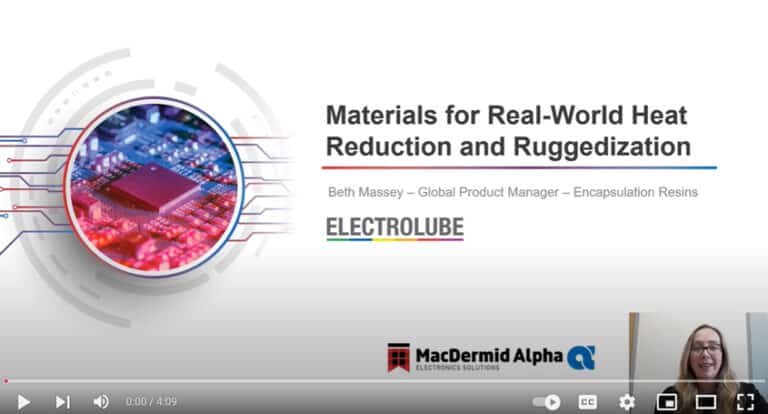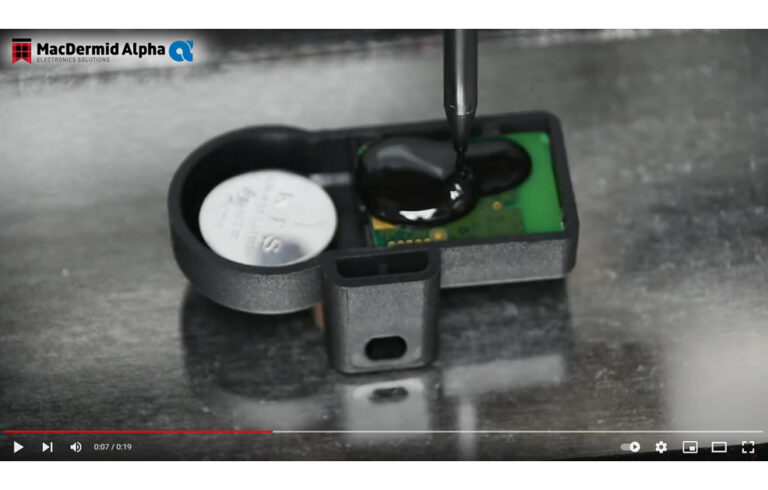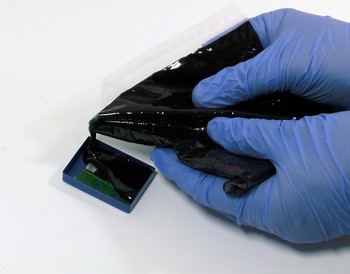In my last blog, I looked at some of the critical things you need to consider before selecting your resin, which covered hardness, colour, viscosity and cure time. I do hope readers found this simple back-to-basics guide a useful starting point for further study and consultation. Of course, when it comes to the choice and application of resins, there’s a lot of information to take in, and over the following months I hope to distil this and provide some useful tips and design advice that will help you in your quest for reliable circuit protection.
Right, you’ve now chosen your two-part resin and it’s time to mix the components and get to work, so this month I’m going to turn my attention to the all-important job of mixing the resin (Part A, to use the terminology) and hardener (Part B), taking care that you get the ratio right and that you are conducting this critical part of the procedure under the right atmospheric conditions, and with all due regard for safety procedures. Get the mix wrong at this early stage and you will not achieve a satisfactory cure, which will ultimately lead to all sorts of problems later on for the product you are potting or encapsulating. We have helpful guides on how to mix Epoxy and Polyurethanes in our Video Section. Anyway, continuing the five-point guide format that I introduced last month, here are five things to make yourself aware of before you start mixing.
Mix ratio – quite possibly the most critical aspect of resin mixing, which will have long term adverse repercussions if you get it wrong! There are two methods of mixing a resin with its associated hardener: by hand or using specialist dispensing equipment. If mixing by hand, then the ratio of the weight of the two components is the more useful method to employ. If mixing using dispensing equipment, then the volume ratio is used.
If the job is relatively small, then you are likely to use a resin pack, which provides the resin and hardener in precise quantities, in separate compartments of the pack. When you are ready to use the product, you simply remove the clip or other separating device between the compartments and ‘massage’ the resulting pouch, ensuring that both components are completely mixed.
For larger production jobs, resin and hardener are likely be supplied in separate bulk containers and you will need to check the shot sizes for each component regularly to ensure that the correct amounts of resin and hardener are being dispensed and mixed correctly.
When mixing bulk resin and hardener, it is important to avoid introducing excessive amounts of air, which will form micro-bubbles within the cured resin. These may expand with the temperature rise to such an extent that they may cause problems. Polyurethane resins are particularly sensitive to moisture, so humid air could also pose problems.
If you are not happy with bulk materials mixing and incurring the potential problems of introducing too much air (and moisture) into the mix, then it might be more appropriate to use automatic mixing equipment, which will accurately mix resin and hardener in the correct proportions, and usually in a controlled atmosphere.
Remember: incorrect ratios will lead to a poor cure and the physical properties of the resin will differ from those specified in the manufacturer’s data sheet.
Viscosity – as well as the viscosity of the mixed system, the viscosity of the two components needs to be considered. Often there is a large difference between the two components, particularly with filled systems, and this could place additional strain on the dispensing equipment’s pumps and pistons. It should also be noted that viscosity of each component will vary depending upon the temperature of the environment in which the mixing and dispensing is taking place.
Useable life/Gel time – The useable life is defined as the time that the mixed resin can flow and is still workable; the gel time is the interval between mixing and the point at which the resin has just set and cannot flow. In the latter state, however, the resin is still relatively soft and can often be re-shaped by applying slight pressure. Gel time is usually quoted for a sample size of 150g, and it is important to note that the larger the volume of mixed resin, the shorter the useable life and gel time. As a general rule, all resins should be mixed and dispensed within their useable life. Fillers generally do not affect the gel time; however it is important that all sedimentation of fillers is mixed back in before mixing the Part A and B together.
Cure temperature – again, this is normally stated for a 150g sample size. Once a resin and its associated hardener are mixed together, the reaction can be very fast but also very exothermic, which can lead to the possibility of a runaway reaction. The exotherm temperature can be controlled by adjusting the volume or by using a filled system, as the fillers absorb some of the heat as well as reducing the concentration of the hardener that promotes this rapid cure. It should be noted that the temperature at which the resin is cured will affect not only the rate of cure, but also the development of cure. Controlling the cure temperature is important because the components requiring potting or encapsulation might be adversely affected by raised temperatures.
Although the volume of the resin applied is important, so is its depth and the surface area it covers. Every application is different, so resin users should take the curing temperature data provided in the manufacturer’s data sheet as a guide to ensure optimum performance of their potting/encapsulation process.
Health and Safety – Resins are generally formulated to be as safe as possible during dispensing and mixing, and certainly safe when cured as part of the end product. However, with the introduction of the ‘Globally Harmonised System of Classification and Labelling of Chemicals’ (more succinctly: GHS), many of the hazards pertaining to resins have been re-assessed and resin chemists have been hard at work to develop safer and better performing resin systems. In any event, users should always study the relevant Safety Data Sheets before using any resin product. In general, Part B (the hardener) is more hazardous than Part A (the resin). Good hygiene practice should always be followed, with gloves, eye protection and suitable clothing worn, and good ventilation/extraction available in the work area.
Well, hopefully the above advice will help get you started as far as resin mixing is concerned. Look out for my next blog, in which I will take a closer look at resin application and tricks of the trade to ensure a smoother application process and more effective cure.
If you have any questions, or would like more information before our next blog, contact our Technical Support Team and they will happily answer your queries.










